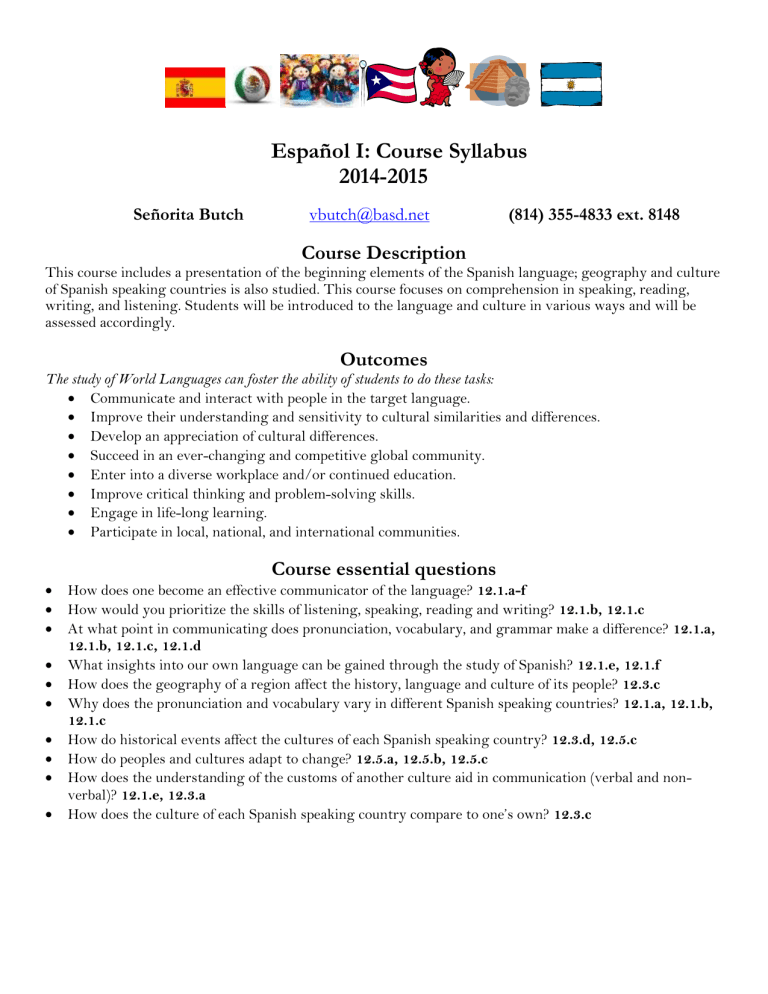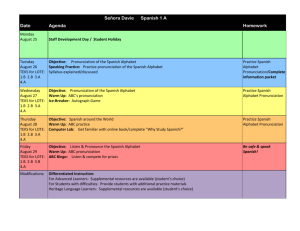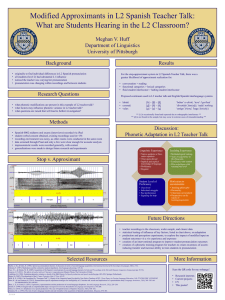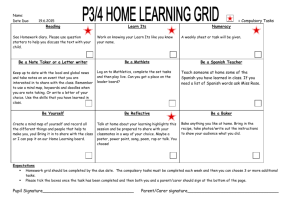Syllabus

Español I: Course Syllabus
2014-2015
Señorita Butch vbutch@basd.net
(814) 355-4833 ext. 8148
Course Description
This course includes a presentation of the beginning elements of the Spanish language; geography and culture of Spanish speaking countries is also studied. This course focuses on comprehension in speaking, reading, writing, and listening. Students will be introduced to the language and culture in various ways and will be assessed accordingly.
Outcomes
The study of World Languages can foster the ability of students to do these tasks:
Communicate and interact with people in the target language.
Improve their understanding and sensitivity to cultural similarities and differences.
Develop an appreciation of cultural differences.
Succeed in an ever-changing and competitive global community.
Enter into a diverse workplace and/or continued education.
Improve critical thinking and problem-solving skills.
Engage in life-long learning.
Participate in local, national, and international communities.
Course essential questions
How does one become an effective communicator of the language? 12.1.a-f
How would you prioritize the skills of listening, speaking, reading and writing? 12.1.b, 12.1.c
At what point in communicating does pronunciation, vocabulary, and grammar make a difference? 12.1.a,
12.1.b, 12.1.c, 12.1.d
What insights into our own language can be gained through the study of Spanish? 12.1.e, 12.1.f
How does the geography of a region affect the history, language and culture of its people? 12.3.c
Why does the pronunciation and vocabulary vary in different Spanish speaking countries? 12.1.a, 12.1.b,
12.1.c
How do historical events affect the cultures of each Spanish speaking country? 12.3.d, 12.5.c
How do peoples and cultures adapt to change? 12.5.a, 12.5.b, 12.5.c
How does the understanding of the customs of another culture aid in communication (verbal and nonverbal)? 12.1.e, 12.3.a
How does the culture of each Spanish speaking country compare to one’s own? 12.3.c
National Standards
COMMUNICATION
Communicate in Languages Other Than English
Standard 1.1: Students engage in conversations, provide and obtain information, express feelings and
emotions, and exchange opinions
Standard 1.2: Students understand and interpret written and spoken language on a variety of topics
Standard 1.3: Students present information, concepts, and ideas to an audience of listeners or readers on a variety of topics.
CULTURES
Gain Knowledge and Understanding of Other Cultures
Standard 2.1: Students demonstrate an understanding of the relationship between the practices and
perspectives of the culture studied
Standard 2.2: Students demonstrate an understanding of the relationship between the products and perspectives of the culture studied
CONNECTIONS
Connect with Other Disciplines and Acquire Information
Standard 3.1: Students reinforce and further their knowledge of other disciplines through the foreign language
Standard 3.2: Students acquire information and recognize the distinctive viewpoints that are only available through the foreign language and its cultures
COMPARISONS
Develop Insight into the Nature of Language and Culture
Standard 4.1: Students demonstrate understanding of the nature of language through comparisons of the language studied and their own
Standard 4.2: Students demonstrate understanding of the concept of culture through comparisons of the cultures studied and their own.
COMMUNITIES
Participate in Multilingual Communities at Home & Around the World
Standard 5.1: Students use the language both within and beyond the school setting
Standard 5.2: Students show evidence of becoming life-long learners by using the language for personal enjoyment and enrichment.
Textbook: Realidades 1
Content (broken up by chapters):
Para empezar: greetings, goodbyes, courtesy, days of the week, months, classroom directions, numbers
0-100, classroom objects, weather, seasons, body parts, time
1.
A: ¿Qué te gusta hacer?: activity vocabulary, like, dislike, infinitives, negatives, expressing agreement/disagreement, music, cognates, vowels a, e, i, Spanish in the community, Spain
B : Y tú, ¿Cómo eres?: personality traits, describe people, cultural perspectives on friendship, adjectives and placement, definite/indefinite articles, literature, cognates with es-, vowels o, u, Spanish in the working world, The Caribbean
2.
A: Tu día en la escuela: school subjects, schedules, subject pronouns, -ar verbs present, pronunciation of the letter c, mathematic connections, connections between Latin, English, Spanish, México
B : Tu sala de clases: classroom objects, location expressions, estar, plurals of nouns and articles, language through gestures, pronunciation of g, Spanish in the working world, Central America
3.
A: ¿Desayuno o almuerzo?: foods and beverages for breakfast and lunch, likes/dislikes, how often something is done, present –er/-ir verbs, me gustan/me encantan, cultural perspectives on meals,
History connections, using a noun to modify another noun, pronunciation of h and j, northern South
America
B: Para mantener la salud : foods and beverages for dinner, food, health, exercise choices, cultural perspectives on diet and health, plurals of adjectives, ser, Where did it come from?, pronunciation of l and ll, southern South America
4.
A: ¿Adónde vas?: locations in community, leisure activities, how to ask questions, cultural perspectives on leisure activities, ir, Origins of the Spanish days of the week, stress and accents,
Historic United States
B: ¿Quieres ir conmigo?: activities outside school, invitations, cultural perspectives on after-school activities, ir+a+infinitive, jugar, Spanish words borrowed from English, pronunciation of the letter d,
Contemporary United States
5. A: Una fiesta de cumpleaños: family vocabulary, celebrations and parties, ages, cultural perspective on family and celebrations, tener, possessive adjectives, Art connection, Diminutives, pronunciation of p, t, q, Videomystery
B: Vamos a un restaurante: descriptions of family members, restaurant vocabulary, table settings, understand cultural perspectives on family celebrations, venir, ser vs. estar, adjectives ending in –
ísimo, pronunciation of b and v, Videomystery 2
Course Expectations/Rules & Procedures
*Students will be held to a high standard for meeting the following expectations:
BE RESPECTFUL
Be respectful of one another’s thoughts and ideas. A mutual respect is expected between all students and the teacher.
Raise your hand when you wish to speak. Excessive talking out and unnecessary disruptions will affect participation grades.
Respect one another’s belongings. Do not touch or move anything that does not belong to you.
Respect the school’s property as well.
Be a team player. Willingness and ability to work with others will be necessary for this class as there are many cooperative learning groups as well as paired groupings. Groups can/will be selected by the teacher, by the students, or randomly.
BE PROMPT & PREPARED
Arrive to class on time. You will be marked tardy if you arrive to class after the second bell has rung.
When you arrive to class sit quietly and complete the bell-ringer activity until you are greeted to signal that class will begin.
Bring all materials needed to class each day. Textbooks and pens/pencils must be brought to class everyday unless you are told otherwise. Points will be deducted from participation if you consistently come to class unprepared.
Stay organized by using a folder or a binder. Handouts should not be stored in the textbook. This causes the binding on the textbook to become undone. Many packets/handouts are provided in this course and a folder/binder is a necessity.
Books must be covered at all times. Please do not cover books with contact paper.
NO LATE WORK IS ACCEPTED. Homework is due at the beginning of the class period. Homework should be completed before arrival to class. If it is being completed at the start of the period it will be a zero.
BE RESPONSIBLE
If you are absent from class you are responsible for finding out what took place in class that day. All missed assignments must be made up or there will be no credit given for them. I will allow three days from the day you are back in class to turn in missed assignments. Any work turned in after those three days will be given a zero.
If you are absent on the day of a test or quiz or oral presentation you must make it up within three days from the date you come back to class. Anything done after that week will be given a zero.
Students who know they will be absent from class) are expected to tell the teacher in advance. By doing so, they will turn in any assignments that will be due. They will also get any assignments, upcoming quiz/test dates and other important information that will be covered that day during class.
If a student misses class but is in the building at any time that day they are required to check in with the teacher.
*If the absence spans over a long period of time please see me in order to talk about making up missed work/tests/quizzes/presentations. Additional time may be given depending on each individual situation.
Academic Dishonesty
Cheating
The following descriptions are all constituted as CHEATING and all parties involved will receive a failing grade along with a written referral to the office:
Using any type of online translator
Copying another student’s assignment and/or doing another student’s assignment for them
Allowing another student to copy your assignment and/or allowing another student to complete your assignment for you
Turning in an assignment that is identical to another student’s when it was instructed to be individualized ORIGINAL work
Plagiarism
- Plagiarism is the dual act of presenting and claiming the words, ideas, data, or creations of others as one’s own. Presenting ideas in the exact or nearly exact wording as found in primary or secondary sources constitutes plagiarism, as does patching together paraphrased statements without in-text citation.
Disciplinary action will be taken for confirmed instances of plagiarism cheating which includes receipt of a failing grade on an assignment and a written referral.
Consequences for not following rules and procedures:
1 st offense: Warning
2 nd offense: Conference between student/teacher
3 rd offense: Call home to parents/ detention
4 th offense: Referral to office
Assessments & Evaluations
All homework, test, quizzes and other given projects/assignments will be given a numerical value.
Grades will be determined by the total number of points you earned divided by the total points allotted for the assignment. * The school’s grading system will be used.
Por ejemplo: A given quiz is out of 45 points.
You earn 43 points on the quiz. 43/45 = 95.5 which will be rounded to a 96% = A.
Participation
Participating in class is vital to learning/understanding the Spanish language. Participation points can be given on any day and can hurt your grade if you do not choose to participate.
*With learning and speaking a foreign language MISTAKES WILL BE MADE! The best way to learn is to make mistakes and learn from them! Do not be afraid to participate if you are not sure of an answer or how to pronounce something. We are all here to learn from one another! Mistakes will be embraced and learned from!!!
Please detach along dotted line and return by Friday, 9/5/2014
---------------------------------------------------------------------------------------------------------------------------
I have read and reviewed ALL components of the class syllabus and rules and procedures. I understand them, acknowledge them, and agree to follow them, fully understanding the consequences for when they are not followed.
Student Signature
Student Name (print) : _______________________________________ Grade: _____________
Student Signature: ____________________________________ Date: ____________________
Parent/Guardian Signature
Printed Name: _______________________________________ Date: _________________
Signature: _________________________________________________________________
Please provide the following information. Circle to indicate your preferred method of contact.
E-mail address: ________________________________________________________________
Telephone number: Home: _________________________________________
Cell: _________________________________________
Work: _________________________________________









